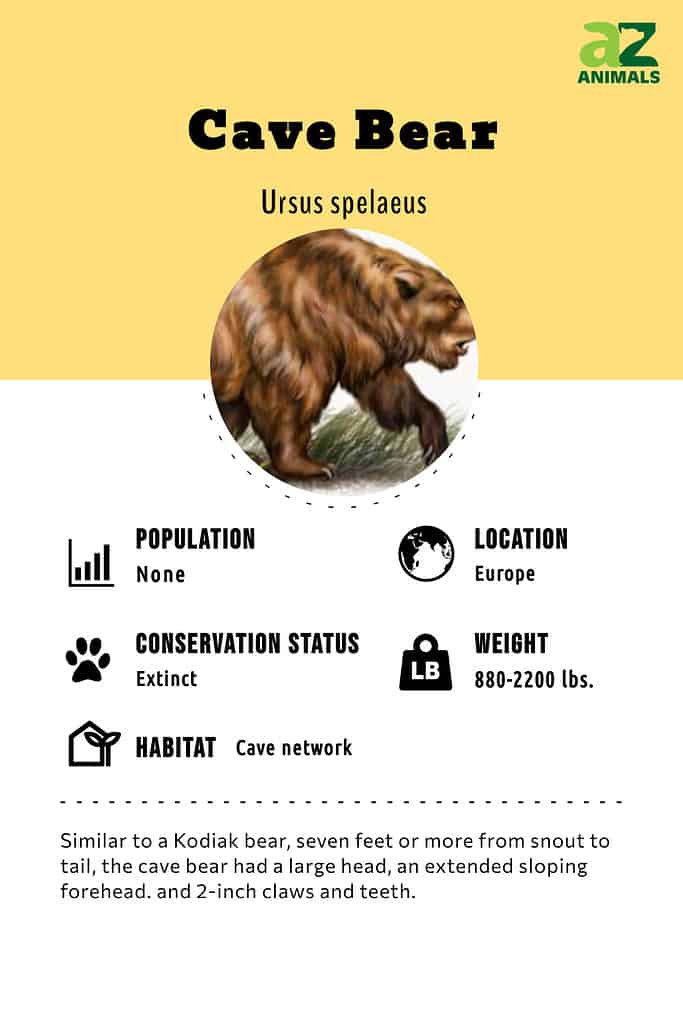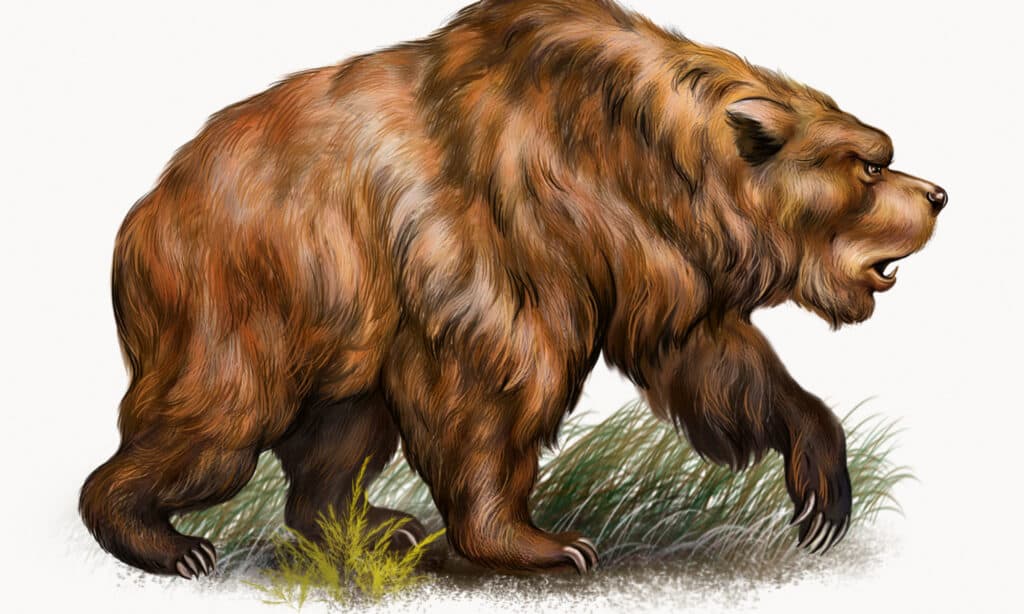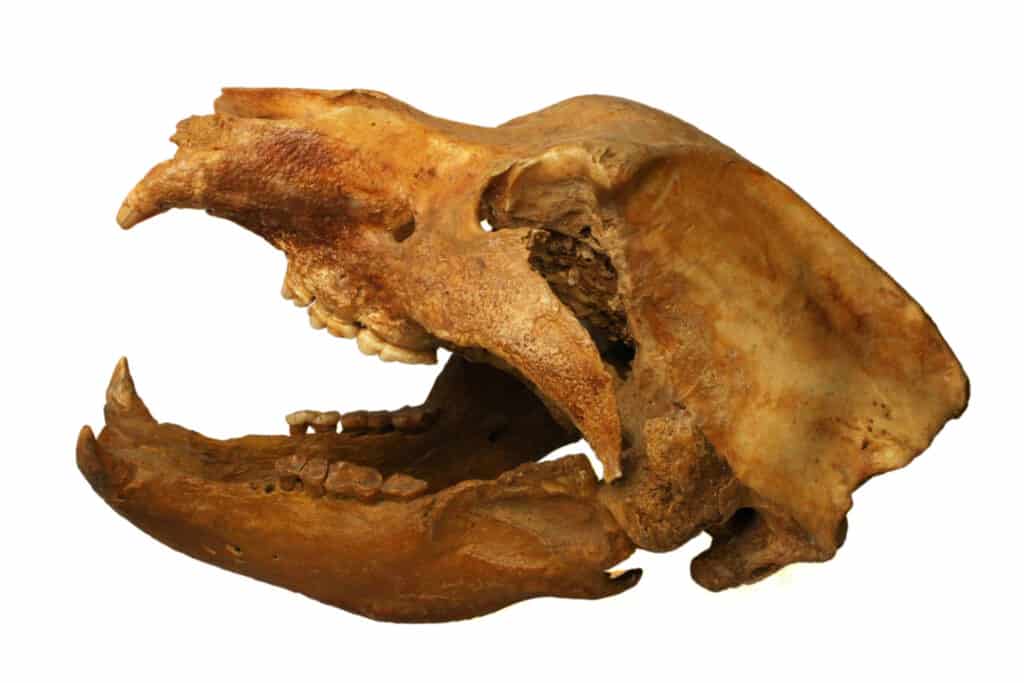Cave Bear
Ursus spelaeus and Ursus deningeri
Cave bears may have been worshiped by primitive humans.
Advertisement
Cave Bear Scientific Classification
- Kingdom
- Animalia
- Phylum
- Chordata
- Class
- Mammalia
- Order
- Carnivora
- Family
- Ursidae
- Genus
- Ursus
- Scientific Name
- Ursus spelaeus and Ursus deningeri
Read our Complete Guide to Classification of Animals.
Cave Bear Conservation Status
Cave Bear Facts
- Diet
- Omnivore
- Favorite Food
- Primarily vegetation augmented with the occasional small animal or fish. Perhaps cannibalized cave bears that died during hibernation.
View all of the Cave Bear images!
Cave bears earned their name by actually spending most of their time within the shelter of cave networks.

Classification
Other pre-historic animals, particularly the dinosaurs, come from classification lines in which maybe the whole Order, Family, and Genus are extinct, but the cave bear is related to all the other bears that we know today. It belongs to the Family Ursidae and Genus Ursus. Only its species Ursus spelaeus, (Ursus meaning “bear” and spelaeus meaning “cave”) is extinct. The name Ursus is widely identified with bears, especially those made famous by astronomers, the constellations Ursa Major and Ursa Minor, or the Great Bear and the Lesser Bear.
The closest living relative to the cave bear is the brown bear since both are descended from Ursus etruscus, which lived about 5.3 million years ago to 100,000 years ago. The cave bear and the brown bear diverged from each other about 1.2-1.4 million years ago. The next ancestor of the cave bear was Ursus deningeri. It is also called “cave bear” because it too lived in caves. It has been found only in Europe and dates from 1.8 million years ago to 100,000 years ago.
Description and Size

The cave bear was the size of modern Kodiak and polar bears, but often larger and heavier with a very large head and sloping forehead.
©Liliya Butenko/Shutterstock.com
Although the general physiology of the cave bear would be identifiable to the modern observer, the massive frame of this ancient species is unlike anything alive today. The typical male cave bear could extend nearly seven feet from snout to tail and easily tip the scales at 2,000 pounds or more. That isn’t dramatically different from the larger Kodiak bears on record, but estimated averages can’t genuinely do justice to the scale of these beasts. One mummified specimen found in Siberia towered at 11.5 feet when standing on its hind legs, and it’s believed that it could have weighed as much as a ton and a half! Females were often half that size, so their fossils were often mistaken for dwarf members of the species.
While its proportions and general appearance aren’t that different from living bear species, the cave bear could be distinguished by its excessively large head and its extended, sloping forehead. A cave bear’s claws and teeth could both grow to nearly two inches long, but they weren’t necessarily built for hunting since they were mostly vegetarian. Despite that, the appearance of serious injuries on many recovered cave bear skeletons suggests that they could hold their own in a fight — and that’s true in the case of tangling with large predators as well as intraspecies conflict over mates and territory.
Diet
While the ferocious countenance and terrifying bulk of the cave bear might elicit visions of a terrifying hunter, it’s believed that cave bears were primarily vegetarian. Like modern panda bears, the teeth of the cave bear were powerful but built for grinding — making them ideal for tearing through and breaking down fiber. Ultimately, the largest influencer in this evolutionary track may have been the cave bear’s size. The energy expenditure for active hunting would be impractical given the sheer bulk of the cave bear. While they technically appear to be omnivorous and may have sometimes fed on small mammals or fish to supplement their primarily vegetative diet, the cave bear wouldn’t have been feeding on humans or similarly sized animals.
From an evolutionary perspective, this dietary discovery reveals additional texture to the history of the bear as a whole. The historical lifespan of the cave bear overlapped with that of the more aggressively omnivorous brown bear — but a 2017 study revealed that the ancestor of both of these bears has a skull shape more closely resembling the cave bear. The conclusion from researchers is that an appetite for flesh only happened later down the evolutionary chain and that the ferocious grizzlies and other bear species we know today represent a divergence. Despite this, there are some signs that cave bears may have cannibalized other members of their species — likely those who died during hibernation — though this seems to have been a rarity. It’s not entirely clear how long the typical cave bear lived, but it’s assumed they didn’t usually live for more than 20 years. That’s comparable to species like the giant panda but as much as a decade less than the modern brown bear.
- Height (Standing): 10 to 11 feet
- Weight: up to 2,200 lbs.
- Claws: 1.5-1.75 inches
- Teeth: 1.5-1.75 inches

A cave bear skull showing its powerful, grinding teeth.
©Tony_Herbert/Shutterstock.com
Habitat
The cave bear earned its name because the majority of remains were found in caves, but those same caves were where they spent most of their lives. While many modern species of bear retreat into caves to hibernate during cold seasons, cave bears actually spent most of their time within the shelter of cave networks. At the height of their population, cave bears stretched throughout much of Europe. Their reach extended from Spain to the west through Italy and Germany and as far east as Georgia, Poland, and Romania. Cave bear populations even extended northward into Russia, but the densest populations seem to have been further south, possibly extending into the Middle East and northern Africa. Cave bear remains have even been found on the British Isles.
Cave bears never seem to have found their way into Scandinavian countries like Finland and Norway, a natural result of the fact that these animals lived during the Pleistocene Epoch. Also known as the Great Ice Age, it penned in much of Europe with giant sheets of ice. Although large, cave bears mostly managed to survive by keeping a low profile. They typically occupied the foothills of mountains and steered clear of open plains in favor of heavily wooded regions. It’s impossible to determine exactly when the cave bear become a distinct species, but it’s generally regarded to have appeared about 100,000 years ago.
Threats And Predators
With an estimated weight of a ton or more, it’s highly unlikely that the cave bear had much in the way of active predators — but records of recovered cave bear fossils reveal that life wasn’t completely without threat for these gargantuan bears. Territorial threats were the most likely cause of conflict between most cave bears and other predators, and the bones of both cave lions and bears have been found together in a state that suggests well-matched conflict. Older and infirm cave bears and cubs may have also been targets for pack hunters like wolves and hyenas.
But the biggest threat to the cave bear may very well have been its own physiology. Because of its massive energy requirements, it was not uncommon for a cave bear to enter hibernation and simply never wake up. Also, there is some evidence to suggest that Neanderthals and early humans may have preyed on cave bears as a food source in the same way that they hunted other megafauna like the woolly mammoth. Whether humans contributed directly to the extinction of the cave bear in the same way is a more complicated question. Teeth marks from Neanderthals have been found on the skeletons of cave bears, and a skull fracture found in 2021 on a 35,000-year-old Siberian cave bear skeleton leads to the belief that humans may have employed more sophisticated tools and hunting methods. But it’s thought that bears were primarily hunted for their fur and the shelter of their cave rather than their meat.
Discoveries and Fossils

Cave bears were primarily vegetarian, though there is fossil evidence that they resorted to cannibalism to stay alive when food was scarce.
©Horia Bogdan/Shutterstock.com
Since they lived a relatively short time ago and occupied some of modern Europe’s most populous countries, there’s been no shortage of cave bear skeletons uncovered over the years. Medieval Europeans often mistook cave bear skeletons for the remains of dragons. By the 18th century, physiologist Johann Friedrich Esper would mistake them for the remains of a polar bear. A single cave in Switzerland was discovered to hold over 30,000 cave bear skeletons, and over 100,000 fossils have been uncovered throughout Europe in total. While some of these were boiled down for phosphate during World War II, there is still an abundance of cave bear remains in the world. The largest number of cave bear fossils are from western Europe, but the cold reaches of Siberia have been a source of discovery for cave bear corpses that have been fully mummified.
Cave bears overlapped with both humans and Neanderthals, and our understanding of our relationship with this ancient species has sometimes been contentious. Cave paintings and bones of cave bears with seemingly ceremonial purposes suggest that these creatures were once worshipped by primitive humans, and it’s even been suggested that both humans and cave bears inhabited the Chauvet cave together — often with gruesome and bloody results. Over 150 bones were found in Chauvet. It’s possible the charcoal drawings in the cave are the oldest representation of art on the planet.
Extinction
Uncovering forensics on a crime that happened roughly 30,000 years ago is difficult, and it’s left researchers with multiple competing theories about what sort of extinction event might have led to the death of the cave bear. Further strengthening the mystery is the fact that cave bears were among the first of the major megafauna to become extinct. While there are a number of theories about what exactly happened, the general consensus is that it was a convergence of varying factors rather than a single incident that led to their extinction.
Humans likely had some part to play in the decline of cave bear populations, but it’s unlikely that they were the sole culprit. Humans and early Neanderthals would have competed with cave bears for habitats, and the large size of the cave bear made it ill-fitted to live out on the surface. Human intervention was probably a factor accelerating what killed fellow megafauna — an extended cold snap that greatly depleted food availability. Rather than drive them to extinction, we likely drove them out into the cold. Cave bears ultimately disappeared from the record somewhere between 24,000 and 30,000 years ago.
Similar Animals
- Kodiak bear – This rare variant of the grizzly bear is roughly comparable in size to the gargantuan cave bear. It can reach a height of 10 feet when standing and weigh-in at 1,500 pounds. The Kodiak is the largest living bear species and has been isolated from other bear species for 12,000 years.
- Brown bear – This close relative looks quite similar to the cave bear despite being significantly smaller, and the two species actually cohabited and even bred together. DNA studies have found genetic materials shared between both species that suggest hybridization. It’s likely that the smaller size of the brown bear allowed it to weather the precipitous temperature drops that killed the cave bear.
- Woolly mammoth – This contemporary of the cave bear and ancestor of the elephant was actually significantly larger than its ursine counterpart. Mammoths could reach a height of 11 feet at the shoulder, and they could weigh as much as six tons. While they managed to survive slightly longer than cave bears, woolly mammoths eventually succumbed to the consequences of climate change.
Cave Bear FAQs (Frequently Asked Questions)
When did cave bears live?
The cave bear first distinguished itself from earlier species roughly 100,000 years ago. It lived throughout the Pleistocene Epoch and became extinct about 25,000 years ago, roughly at the same time as many other megafauna species.
How big was the cave bear?
A male cave bear could extend to a height of 11 feet and weigh as much as a ton. Females were typically about half this size and were previously mistaken for dwarf variations of the species.
Thank you for reading! Have some feedback for us? Contact the AZ Animals editorial team.
Sources
- Science Daily, Available here: https://www.sciencedaily.com/releases/2010/08/100824082230.htm
- Britannica, Available here: https://www.britannica.com/animal/cave-bear
- Thought Co., Available here: https://www.thoughtco.com/facts-about-the-cave-bear-1093335
- Books Google, Available here: https://books.google.com/books?hl=en&lr=&id=1-53vplW1mgC&oi=fnd&pg=PP11&dq=cave+bear&ots=meFYKaRyaf&sig=DFnPy2SSlHhwOX3vk1X8NvOiJ2s#v=onepage&q=cave%20bear&f=false
- NBC News, Available here: https://www.nbcnews.com/id/wbna42766165
- Smithsonian Magazine, Available here: https://www.smithsonianmag.com/history/fate-of-the-cave-bear-69538895/
- The Wire, Available here: https://thewire.in/environment/genetic-study-says-humans-drove-cave-bears-to-extinction-not-climate
- Alaska Department of Fish & Game, Available here: https://www.adfg.alaska.gov/index.cfm
- Smithsonian Magazine, Available here: https://www.smithsonianmag.com/smart-news/dna-extinct-cave-bear-lives-modern-brown-bears-180970151
- Blog Ted, Available here: https://blog.ted.com/10-fascinating-facts-about-woolly-mammoths
- Science Daily, Available here: https://www.sciencedaily.com/releases/2021/10/211020135914.htm

















